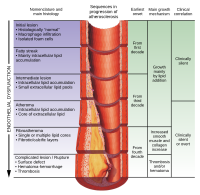
Photo from wikipedia
BACKGROUND Endothelial TGF-β1 signaling is a primary driver of atherosclerosis-associated vascular inflammation. Targeted imaging and inhibition of the expression of TGF-β1 may reduce the atherosclerotic vessel wall inflammation and stop… Click to show full abstract
BACKGROUND Endothelial TGF-β1 signaling is a primary driver of atherosclerosis-associated vascular inflammation. Targeted imaging and inhibition of the expression of TGF-β1 may reduce the atherosclerotic vessel wall inflammation and stop the progression of atherosclerotic plaque. PURPOSE To investigate the possibility of the anti-TGF-β1-ultrasmall superparamagnetic iron oxide (USPIO) specific probe as an imaging marker for the expression of TGF-β1 in ApoE-/- mice atherosclerosis detected with 7.0-T magnetic resonance imaging (MRI). MATERIAL AND METHODS Here, 70 ApoE-/- mice on a high-fat diet served as the experimental group and 30 C57BL/6 mice on a normal diet served as the control group. The morphology of plaques was viewed by H&E staining, and the expression and distribution of TNC and TGF-β1 were detected by immunohistochemical staining. Another 40 mice in the experimental group were classified into a targeted group, which was administrated an anti-TGF-β1-USPIO probe, and the pure group, which was injected with pure USPIO. RESULTS The 7.0-T MRI showed that the relative signal intensity (rSI) changes of the targeted group decreased more than those of the pure group (-19.34 ± 0.68% vs. -5.61 ± 0.57%; P < 0.05). Histopathological analyses demonstrated expression of TGF-β1 in atherosclerotic plaque formation progression from 10 to 28 weeks. The MR images of the expression of TGF-β1 in atherosclerosis correlated well with the pathological progression of atherosclerotic plaque formation. CONCLUSIONS Anti-TGF-β1-USPIO could provide a useful molecular imaging tool for detecting and monitoring the expression of TGF-β1 in atherosclerotic plaques by MRI.
Journal Title: Acta radiologica
Year Published: 2023
Link to full text (if available)
Share on Social Media: Sign Up to like & get
recommendations!